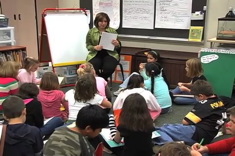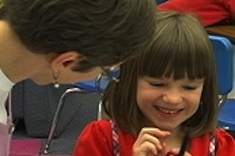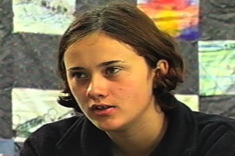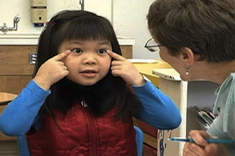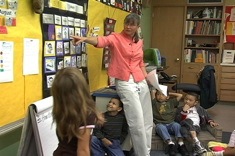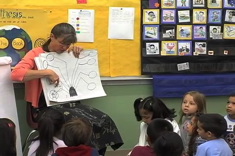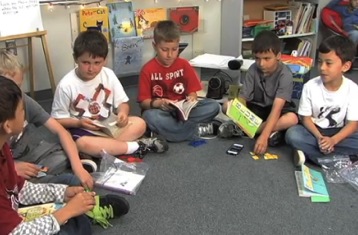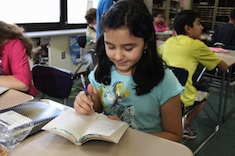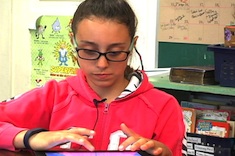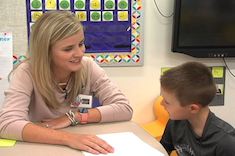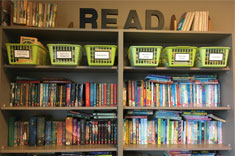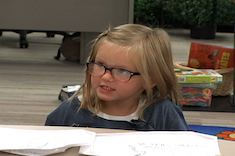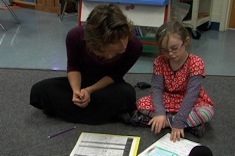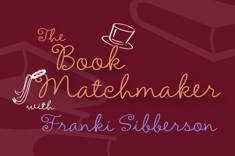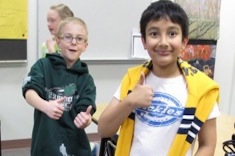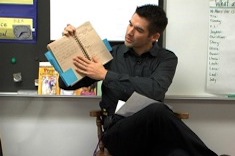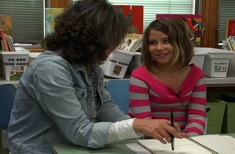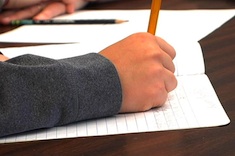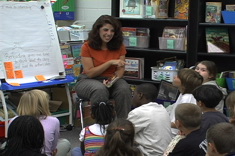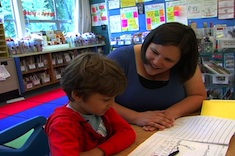Videos
Here is where you’ll find all the latest videos from our contributors. These videos are all captured in classrooms with crews using multiple cameras during regularly scheduled reading and writing workshops.
Latest Content
Fonts Lesson: A Revision Strategy for Transitional Writers
Franki Sibberson teaches a minilesson on fonts as a revision strategy for her grades 3 and 4 students.
Reflection Sheets: A Tool for Assessment and Conferring
Franki Sibberson explains how “reflection sheets” work as an assessment tool in her classroom, replacing detailed notes from conferences.
Fonts: Small Group and Conferring with Intermediate Writers
In this follow-up to a whole class lesson and discussion of fonts, Franki Sibberson pulls together a group of 3rd and 4th graders from her class who have asked to be a part of a small group on fonts.
Concepts of Print: Conferring with a Kindergartner
In this conference with five-year-old Mariano, Joan Moser (of “The Sisters”) assesses his understanding of reading, print, and books at the start of the school year.
Conferring with a Child in the “Silent Period”
Larisa is a six-year-old who speaks Russian at home, and is in the “silent period” in school. In this conference, Ruth Shagoury demonstrates different strategies for eliciting responses from Larisa.
Writing About a War-Torn Home: Zerina Talks About Finding Her Writer’s Voice
In this interview with Ruth Shagoury, English language learner Zerina talks about her growing confidence as a writer as she shares her writing with high school classmates. She also talks about how her father encouraged her to write down her most poignant memory of war in their homeland, Bosnia.
Conferring with Anna
Anna is a five-year-old student in an Oregon kindergarten classroom who speaks Vietnamese at home. In this conference with Ruth Shagoury, she shares writing about her classmates and a snake, testing out her growing knowledge of the alphabet, sounds, and the purposes of writing.
Every Language Counts: Adding Multilingual Counting Activities to Morning Meeting
Every year kindergarten teacher Andie Cunningham has children who come from homes with many different first languages. She helps welcome these different languages and cultures into the classroom community by counting in different languages during the morning meeting.
Spacing Words: A Minilesson with Young Writers
In this two-minute video, Andie Cunningham reinforces the concept of spacing words with her kindergartners using her own writing and a brainstorming web.
Listen In: Jeffry’s Ocean Story
Moving a child from simple to complex sentences is the goal in this second-grade writing conference.
Boys’ Book Club in Second Grade
In this video from Linda Karamatic’s second-grade classroom, boys discuss the book Fudge using the protocol provided by Linda.
Mentor Texts and Teacher Modeling: The Listing Strategy
In this video from her fourth-grade classroom, Aimee Buckner teaches the “listing” strategy, using the book This Is the Tree: A Story of the Baobab as a mentor text. Aimee talks about mentor texts, using her own writing as a model, and the needs of intermediate readers and writers during the lesson and interview.
Conferring in Kindergarten: Drawing to Learn
Hayley Whitaker confers with a kindergartner and helps him make meaning through drawings.
Conferring on Inferring in Second Grade
Linda Karamatic works with a student who is reading the Stink series as he tries out a new tool for documenting inferences as he reads.
Setting the Room for Collaboration
Gretchen Schroeder offers advice on how to arrange a high school classroom for collaboration.
Reading Nonfiction: A Paper Anchor Chart
Tammy Mulligan explains her process of using multiple versions of an anchor chart to help students remember and personalize a process for reading nonfiction texts.
Book Matchmaker: Read Alouds That Invite Young Readers to Participate
Franki Sibberson shares her latest suggestions for read alouds that invite participation from young readers.
Kindergarten: Conferring with Grace
Hayley Whitaker confers with Grace about her writing early in the year.
Goals and How-to Writing in First Grade
Danielle French helps a first grader set nonfiction writing goals.
Book Matchmaker: 3rd Graders Reading Below Grade Level
In this installment of Book Matchmaker, Franki Sibberson shares her favorite books for 3rd graders who are not at grade level, but don’t want to read texts that will embarrass them in front of their peers.
Lifting the Quality of Peer Response
Tony Keefer discovers that his fourth-grade students need focused instruction and support to strengthen their peer conferring skills. Tony shares tips and two video examples from his classroom.
Writing Partner Feedback in Fifth Grade
Fifth-grade writers in Franki Sibberson’s classroom encourage each other and suggest revisions to their opinion-writing drafts in partner teams.
Finding Topics in Writer’s Notebooks Minilesson
Sean Moore shares the importance of using a writer’s notebook to discover topics in this minilesson with his second-grade students from early in the year.
Collecting Ideas in the Writer’s Notebook
Ruth Ayres confers with third grader Jade about the importance of the “collecting” phase for writers.
Conferring with Spencer: Writing Notebook Topics
Katherine Sokolowski helps fifth grader Spencer brainstorm topics for his writing notebook.
Teaching Rereading During Class Read Alouds
Aimee Buckner teaches her 4th graders the power of rereading using the mentor text Goblins in the Castle by Bruce Coville.
First-Grade Writing Conference: Celebrations to Suggestions
Katrina Edwards begins her conference with first grader Allen by celebrating all he is doing well in his writing. She highlights his language and details in writing, before moving on to new strategies to try.
Revising Titles Minilesson
In this minilesson from Franki Sibberson’s grades 3 and 4 classroom, Franki takes students through the process of selecting and revising titles. She uses the poem “Confessions of a Reader” by Carol Wilcox as a mentor text.
A Minilesson on Minilessons
Franki Sibberson leads a minilesson in her fifth-grade classroom to help students design their own lessons. Students also assess what goes into a high-quality minilesson.
Browse Content By
Type
Category
- Assessment Tools
- Big Fresh Archives
- Booklists
- Choice Numeracy
- Classroom Design
- Common Core
- Community Building
- Conferring
- Content Literacy
- Digital Literacy
- English Language Learners
- Equity
- Family Relations
- Free Samples
- Guiding Groups
- Leadership
- Literacy Coaches
- Mentor Texts
- Minilessons
- New Teacher Mentors
- Podcasts
- Poetry
- Quote Collections
- Reading Strategies
- Self Care
- Struggling and Striving Learners
- Talking and Listening
- Teacher Study Groups
- Teaching Reading
- Teaching Writing
- Word Study and Vocabulary
Author
- Melissa Quimby
- Nawal Qarooni
- Gwen Blumberg
- Julie Cox
- The Lead Learners
- Hannah Tills
- Josie Stewart
- Ruth Metcalfe
- Mallory Messenger
- Becca Burk
- Jodie Bailey
- Vivian Chen
- Mary Brower
- Tiffany Abbott Fuller
- Stephanie Affinito
- Ruth Ayres
- Leigh Anne Eck
- Heather Fisher
- Shari Frost
- Julie Johnson
- Suzy Kaback
- Gigi McAllister
- Shirl McPhillips
- Melanie Meehan
- Cathy Mere
- Debbie Miller
- Tara Barnett and Kate Mills
- Tammy Mulligan
- Dana Murphy
- Bitsy Parks
- David Pittman
- Brenda Power
- Heather Rader
- Matt Renwick
- Mandy Robek
- Christy Rush-Levine
- Gretchen Schroeder
- Jen Schwanke
- Brian Sepe
- Katherine Sokolowski
- Stella Villalba
- Jennifer Vincent
Grade Level
Choice Literacy Membership
Articles
Get full access to all Choice Literacy article content
Videos
Get full access to all Choice Literacy video content
Courses
Access Choice Literacy course curriculum and training


